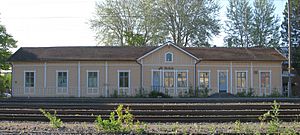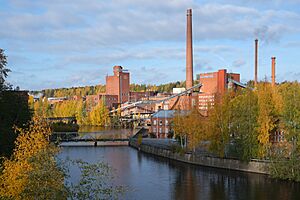Nokia, Finland facts for kids
Quick facts for kids
Nokia
|
||
|---|---|---|
|
Town
|
||
| Nokian kaupunki (Finnish) Nokia stad (Swedish) |
||

Nokia railway station
|
||
|
||

Location of Nokia in Finland
|
||
| Country | ||
| Region | Pirkanmaa | |
| Sub-region | Tampere sub-region | |
| Metropolitan area | Tampere metropolitan area | |
| Charter | 1922 | |
| Market town | 1937 | |
| City rights | 1977 | |
| Area
(2018-01-01)
|
||
| • Total | 347.76 km2 (134.27 sq mi) | |
| • Land | 288.3 km2 (111.3 sq mi) | |
| • Water | 59.58 km2 (23.00 sq mi) | |
| Area rank | 237th largest in Finland | |
| Population
(2023-12-31)
|
||
| • Total | 35,647 | |
| • Rank | 33rd largest in Finland | |
| • Density | 123.65/km2 (320.3/sq mi) | |
| • Demonym | Nokialainen (Finnish) | |
| Population by native language | ||
| • Finnish | 96.1% (official) | |
| • Swedish | 0.3% | |
| • Others | 3.6% | |
| Population by age | ||
| • 0 to 14 | 0% | |
| • 15 to 64 | 20,953% | |
| • 65 or older | 0% | |
| Time zone | UTC+02:00 (EET) | |
| • Summer (DST) | UTC+03:00 (EEST) | |
Nokia is a town in the Pirkanmaa region of Finland. It sits by the Nokianvirta river, which is part of the Kokemäki River system. Nokia is located in the Tampere metropolitan area, about 15 kilometers (9 miles) west of Tampere.
The town of Nokia has a population of about 34,000 people. The larger Tampere metropolitan area has around 420,000 residents. Nokia is the 33rd largest municipality in Finland. It is also the second largest town in the Pirkanmaa region, after Tampere.
Nokia shares borders with several other towns: Hämeenkyrö, Pirkkala, Sastamala, Tampere, Vesilahti, and Ylöjärvi. Tampere Airport is about 16 kilometers (10 miles) away by road, around Lake Pyhäjärvi.
Contents
What's in a Name? The Meaning of Nokia
The name Nokia has a bit of a mystery around it. In modern Finnish, noki means "soot." The word nokia is a plural form, but it's not used much today.
The most popular idea is that the name comes from an old Finnish word, nois (plural: nokia). This word or nokinäätä ("soot marten") used to mean a sable. Sables are small, dark-furred animals. After sables disappeared from Finland, the word was used for any dark-coated fur animal, like the marten. Martens still live in the Nokia area today.
The sable is even shown on Nokia's coat of arms. However, some newer studies suggest that sables might never have lived in Finland. Instead, the name nois might have referred to the beaver. The coat of arms was designed by Gustaf von Numers and approved in 1951.
A Look at Nokia's History
The first time Nokia was mentioned in writing was in 1505. A document talked about two farms called Stoora och Lilla Nokia, which means "Big and Little Nokia" in Swedish. These two farms later became the Nokia manor. This area was part of the Pirkkala church parish.
Nokia was the site of a big battle during the Cudgel War in 1596. This was a peasant uprising against powerful lords. The peasants, who fought with clubs, stayed at Nokia Manor. They won some small fights against the lords' horse soldiers. But they were badly beaten by Klaus Fleming on January 1–2, 1597. Thousands of peasants were killed. Their leader, Jaakko Ilkka, was caught and executed later. The Cudgel War was the last major peasant revolt in Finland. It made the nation-state stronger.
Much later, during the Finnish Civil War in 1918, Nokia was a strong base for the Red Guards. There was some fighting in the area.
In 1922, a larger area called Suur-Pirkkala was divided into Northern and Southern Pirkkala. Nokia used to reach into what is now the center of Tampere. The Pispala area was part of Nokia (Northern Pirkkala) until 1937. In 1938, Northern Pirkkala was renamed Nokia. Southern Pirkkala became simply Pirkkala. Two other towns joined with Nokia: Suoniemi in 1973 and Tottijärvi in 1976. Nokia officially became a city in 1977.
Nokia's Industrial Past
The famous telecommunications company Nokia has its early roots here. In 1868, a mining engineer named Fredrik Idestam built his second paper mill by the Nokianvirta river, near the town of Nokia. His businesses were named Nokia Aktiebolag (Nokia Ltd) in 1871.
Later, Suomen Gummitehdas Oy (Finnish Rubber Works Ltd) opened a factory in Nokia in 1904. These two companies, along with Suomen Kaapelitehdas Oy (Finnish Cable Works Ltd), joined together in 1967. They formed the Nokia Corporation.
Between 1988 and 1996, different parts of this large company were split off or sold. The rubber works still operate in Nokia today as Nokian Tyres. The paper mill, which started in 1880, is now part of Essity.
Even though the Nokia Corporation started in Nokia, it no longer has any operations in the city. The telecommunications part of the business began in the early 1960s in Helsinki. Later, the main office moved to the Capital Region. Today, Nokia's headquarters are in Espoo.
The only thing left of the company in the city is the Nokia mansion. This mansion is sometimes used for private events for the company's leaders. The city has been asked many times to honor the company it gave birth to. However, it has always said no. This is because mobile phones were never actually made there.
Nokia does have a SoC R&D (research and development) unit. It is about 15 kilometers (9 miles) away in the nearby city of Tampere.
Nokia Today
Today, Nokia is known for its spa, factory shops, and beautiful waterways. It also hosts many events. The town has good road and air connections. Some of the largest companies in Nokia include AGCO Power, Nokian Tyres, Purso, Patria Aviation, and the Essity paper mill.
For people interested in religion, Nokia is famous for the exciting Nokia Revival. This religious movement began in 1990. Nokia is also known for its own special fast food, called Kuuma koira. It is also home to the Nokian Brewery. Because it is close to Tampere's film studios, Nokia has also been used as a place to film movies and TV shows. For example, Eric Sykes' movie The Big Freeze and the Finnish TV show Korpelan Kujanjuoksu were filmed there.
Population Growth
The following graph shows how Nokia's population has grown since 1964.
| Nokia's population growth in 1964–2020 | ||||
|---|---|---|---|---|
| Year | Population | |||
| 1964 | 18 455 | |||
| 1980 | 23 644 | |||
| 1985 | 24 325 | |||
| 1990 | 26 063 | |||
| 1995 | 26 287 | |||
| 2000 | 26 905 | |||
| 2005 | 29 147 | |||
| 2010 | 31 647 | |||
| 2015 | 33 162 | |||
| 2020 | 33 966 | |||
| Sources: Statistics Finland; Historian suursanakirja. | ||||
Famous People from Nokia
Many talented people have come from Nokia or lived there:
- Markku Aro – a singer
- Marko Asell – an Olympic wrestler
- Roope Hintz – an ice hockey player
- Kikka – a pop singer
- Otto Koivula – an ice hockey player
- Toivo Kärki – a composer, musician, producer, and arranger (born in an area now part of Nokia)
- Jari Niemi – a football player
- Kari Peitsamo – a musician
- Tapio Rautavaara – an athlete, musician, and actor (born in an area now part of Nokia)
- Elsa Rautee – a poet
- Anssi Salmela – an ice hockey player
- Sami Sandell – an ice hockey player
- Sanni Vanhanen – an ice hockey player
- Juuso Välimäki – an ice hockey player
- Sami Välimäki – a professional golfer
Distances to Other Cities
Here are the distances from Nokia to some other cities and towns:
- Tampere – 15 km (9 miles)
- Sastamala – 35 km (22 miles)
- Hämeenlinna – 80 km (50 miles)
- Pori – 95 km (59 miles)
- Rauma – 125 km (78 miles)
- Turku – 150 km (93 miles)
- Helsinki – 180 km (112 miles)
- Vaasa – 240 km (149 miles)
Twin Towns
Nokia has "twin town" relationships with these cities:
Gallery
-
Vihola marina
See also
 In Spanish: Nokia (ciudad) para niños
In Spanish: Nokia (ciudad) para niños











